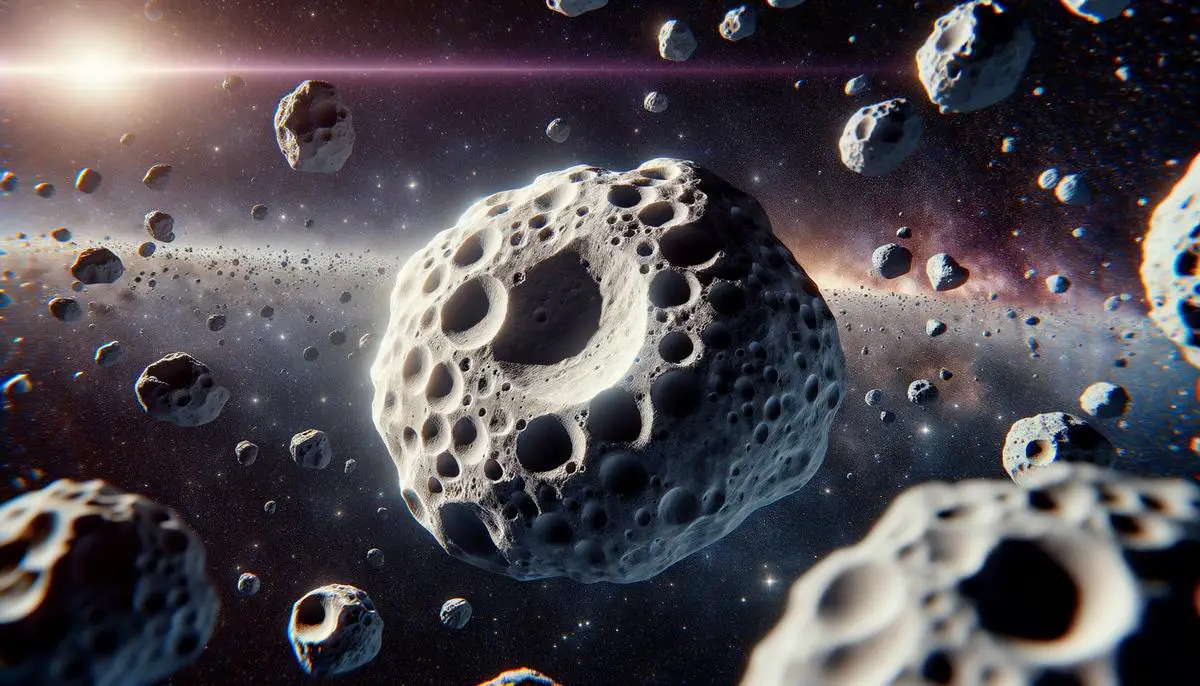Vesta's Orbital Characteristics
Vesta orbits the Sun in the asteroid belt between Mars and Jupiter, completing one circuit every 3.6 years. Its orbit is moderately inclined at 7.1 degrees, meaning it tilts slightly compared to the plane of the solar system. The orbit has an eccentricity of 0.09, indicating it's not a perfect circle but rather a slightly stretched ellipse.
At its furthest point from the Sun, Vesta reaches 2.57 astronomical units (AU), known as its aphelion. At its closest approach, or perihelion, Vesta is 2.15 AU away. For comparison, Earth's distance from the Sun ranges between 0.98 AU and 1.02 AU. Unlike Earth, Vesta's orbit lies entirely within that of Ceres, the largest asteroid in the belt.
Occasionally, Vesta can capture other smaller asteroids into temporary 1:1 resonant orbital relationships. This means that for a short time—up to a couple of million years—some asteroids will share the same orbital period as Vesta. Currently, forty such companions have been identified.
Due to these orbital characteristics, Vesta's speed varies along its path around the Sun. When closer to the Sun at perihelion, it moves faster due to the stronger gravitational pull. Conversely, it slows down at aphelion. This variance in speed affects Vesta's ability to occasionally capture those aforementioned asteroid companions.
Vesta's axial tilt is about 29 degrees, meaning its rotational axis is significantly tilted relative to its orbital plane. It completes one rotation every 5.342 hours, making its day much shorter than ours.
Earth's Orbital Characteristics
Earth's orbit is more circular than Vesta's, with an eccentricity of 0.0167, meaning Earth's path around the Sun is nearly a perfect circle. In terms of its tilt, Earth's orbit is inclined by about 0.00005 degrees to the plane of the solar system, which is almost negligible compared to Vesta's more pronounced 7.1 degrees.
At its furthest distance from the Sun, Earth reaches an aphelion of approximately 1.0167 AU, and at its closest approach, or perihelion, it comes within about 0.9833 AU. Unlike Vesta, whose orbit lies in the asteroid belt, Earth's orbit is positioned in the habitable zone – a region where temperatures allow for liquid water, a fundamental prerequisite for life as we know it.
Earth's relatively low eccentricity contributes to a relatively stable climate, as the variation in distance from the Sun throughout the year doesn't lead to extreme temperature differences.
While Earth's axial tilt is about 23.5 degrees, Vesta's is slightly greater at 29 degrees. This axial tilt on Earth introduces our seasons, as different parts of the Earth receive varying amounts of solar energy throughout the year. For Vesta, such a tilt also suggests seasonal variations, though its faster rotation period of just over 5 hours creates much shorter days than Earth's 24-hour cycle.
Earth's isolated position allows for a relatively stable orbit with fewer temporary orbital companions compared to Vesta's 40 identified asteroid companions. This difference can be attributed to the gravitational influences Earth avoids, thanks in part to its distance from the asteroid-dense regions of space.
Comparative Analysis of Orbital Speeds
Vesta and Earth's orbital speeds are influenced by their distances from the Sun and their respective masses. Vesta, residing in the asteroid belt between Mars and Jupiter, orbits farther from the Sun compared to Earth. According to Kepler's laws of planetary motion, a celestial body's orbital speed decreases with an increase in its distance from the Sun1. Thus, Vesta moves at a slower average speed of about 19 km/s compared to Earth's 29.78 km/s2. This difference stems from the fact that gravitational force weakens with distance; being farther from the Sun, Vesta feels a weaker gravitational pull.
The masses of these celestial bodies also play a crucial role in influencing their orbital dynamics. Earth, with a significantly larger mass, exerts a stronger gravitational force within its environment, helping maintain a relatively stable orbit. Vesta, on the other hand, is much smaller in mass compared to Earth. This lower mass means Vesta has less gravitational influence on its surrounding space, making it more susceptible to perturbations from nearby giants like Jupiter.
Jupiter's gravity exerts a notable influence on Vesta's orbit. The gas giant's immense mass creates gravitational perturbations that can slightly alter the orbits of nearby asteroids. For Vesta, these interactions can result in orbital resonances that affect its speed and trajectory over time. When Vesta and Jupiter's orbits synchronize in particular ways, Vesta can experience minor variations in its path, leading to changes in its speed.
Additionally, Jupiter's gravitational influence contributes to the complex dynamical environment of the asteroid belt. This influence can lead to temporary capture and release of small asteroids in resonant orbital relationships with Vesta, further complicating Vesta's orbital characteristics. Though these gravitational interactions can appear subtle, over astronomical timescales, they play significant roles in shaping the asteroid's long-term orbital behavior.
In contrast, Earth's isolated position and greater distance from the asteroid belt mean it remains relatively unaffected by such intense gravitational perturbations. Earth's more stable orbit, with fewer temporary companions, results in a more consistent and predictable orbital speed.
- Kepler J. Astronomia nova. Heidelberg, Germany: Voegelin; 1609.
- NASA. Vesta: Facts & Figures. Accessed April 12, 2023. https://solarsystem.nasa.gov/asteroids-comets-and-meteors/asteroids/4-vesta/in-depth/.
![]()
